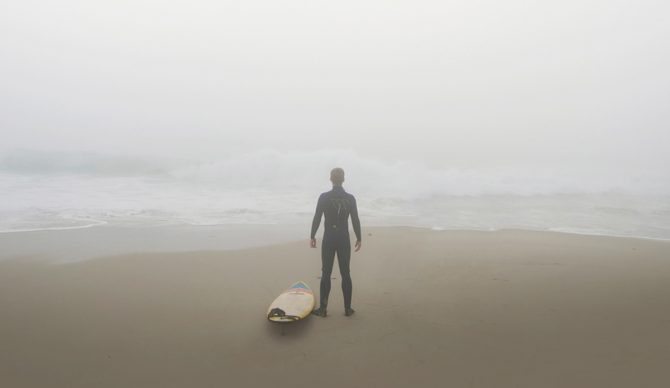
A few storied waves have disappeared into the mist. Here’s the iconic spots that have risen from the ashes. Photo: Frank McKenna//Unsplash
Wave pools are all the rage, but they’re not the first man-made surf spots. Some of the world’s most renowned breaks are the result of human intervention on the coastline. Though we may look at the back-to-back sets of the Superbank and praise the marvels of human engineering, sometimes a wave has to die for a new one to be born. Here are the stories of three man-made surf breaks and the waves that went extinct in order to create them.
The Superbank Changed Kirra From Icon to Footnote
The Gold Coast’s Superbank is not only a magnet for ridiculously good surfing, it’s also a successful experiment in environmental engineering. In the ’60s, training walls were added to the mouth of the Tweed river in order to make it more navigable for ships and swimmers, but by the ’80s, sand had begun to build up along Letitia Spit and the nearby beaches were experiencing significant erosion.
In response, the New South Wales and Queensland governments decided to pump sand out of the Tweed River in hopes that the currents would redistribute it and rebuild the northern beaches. What resulted was the Superbank, a two-kilometer long sand bar starting at Snapper Rocks and ending at Kirra.
However, while Snapper Rocks was transformed into the world-renowned break we know today, the once-great Kirra was an unintended casualty of the Superbank’s creation. The former jewel of the Gold Coast surf scene became a shadow of its former self, paling in comparison to the endless, barreling sets from Snapper to Greenmount.
As Matt Rode of Magic Seaweed wrote, “Within a few seasons, so much sand had drifted between the fabled groynes that Kirra Beach extended past where the lineup had once been. There was literally dry sand where the wave used to break – and just like that the legendary Kirra was gone.”
Magic Island Erased Garbage Hole and Created Ala Moana Bowls
View this post on Instagram
In a real “Boy named Sue” situation, Garbage Hole may have had the greatest ratio of epic waves to unappealing name (Shitpipe being the out-and-out winner of the worst-name contest). The hollow peak was christened for the floating trash that would emerge from the nearby canal and swirl through the lineup. However, despite the off-putting moniker, Garbage Hole was a renowned wave. The spot was even briefly featured in Bruce Brown’s classic The Endless Summer, where you can see Wayne Miyata scoring a tube at the storied break.
However, by the time The Endless Summer was released, Garbage Hole was gone. In 1964, Magic Island was constructed – a man-made peninsula that was intended to be the home of a resort hotel complex that never came to fruition. The foundation of Magic Island filled in the reef at Garbage Hole, erasing the wave forever.
What emerged from the ashes was Ala Moana Bowls, a gem of the South shore. Every time a South swell hits, Ala Moana erupts into Honolulu’s premiere wave, and the legacy of Garbage Hole lives on.
Tragedy Humbles Corona Del Mar and Births The Wedge
During the 1920s and early ’30s, Corona del Mar, located at the Newport Harbor entrance in Orange County, was one of the best waves in the world. Among the watermen to frequent the break were surf legends Duke Kahanamoku and George Freeth.
In 1934, George Rogers lobbied Congress to fund a harbor improvement project to make the entrance safer for boaters. The decision came as a result of a tragedy: Rogers’ son, George Jr., was piloting a speedboat that was overturned by a wave in the harbor. Due to the metal leg braces he wore from a bout with childhood polio, George Jr. was pulled to the bottom and never resurfaced.
That, along with other deadly boat accidents (including one in which the Duke himself rescued eight men) led to the construction of the jetty that stands today. Soon after, the break at Corona Del Mar faded away, lost to history.
Though George had slain the monster at the entrance of the Newport harbor, a new leviathan rose up in its place. The same jetty that made the entrance safer for boaters birthed The Wedge, one of the biggest, gnarliest and most unpredictable shore breaks in the world. It’s somewhat of a cruel irony that a project undertaken by a grieving father to make the ocean a little bit safer created one of the scariest waves in Southern California.

